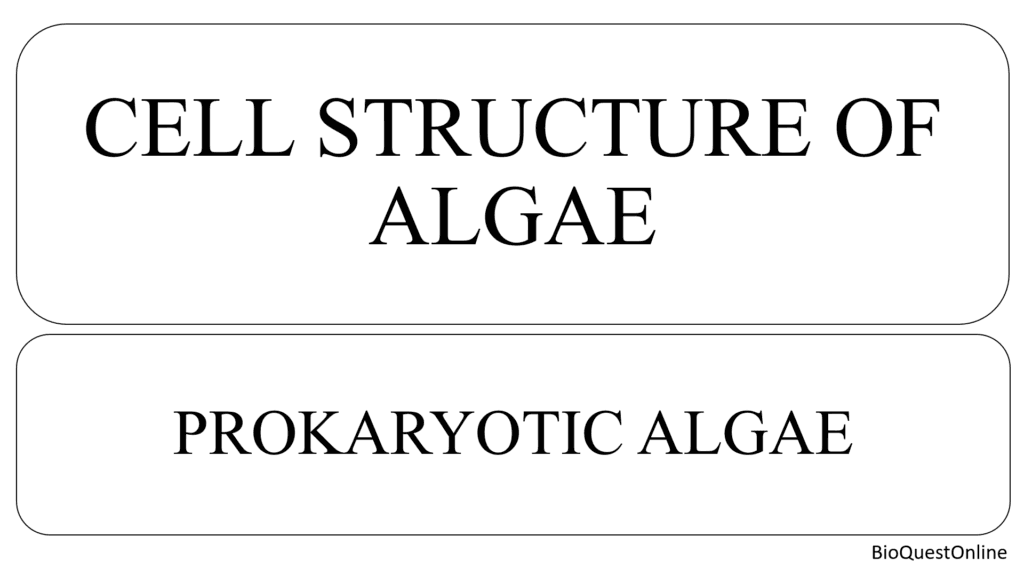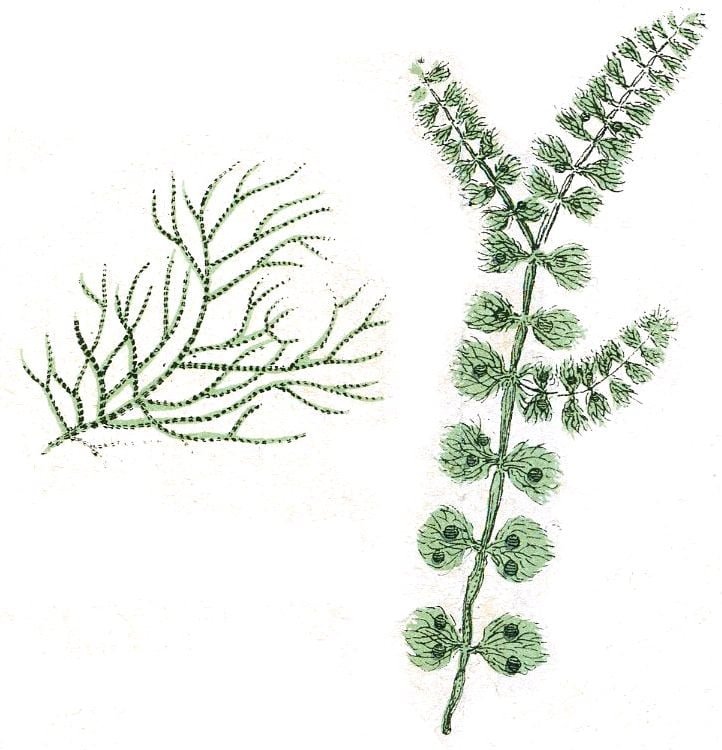Cell structure of prokaryotic algae reveals the presence of a incipient nucleus which lacks a nuclear membrane, and the DNA is dispersed within the nucleoplasm. The cytoplasm does not contain key organelles such as mitochondria, endoplasmic reticulum, or chloroplasts.
Prokaryotic algae include the organisms previously known as blue-green algae, formerly classified as Cyanophyceae or Myxophyceae, but now referred to as Cyanobacteria due to their prokaryotic cell structure.
Cell Structure of Prokaryotic Algae
Cell structure of prokaryotic algae consist of cell wall, cell sheath, photosynthetic lamellae, granular inclusions in cytoplasm, gas vesicles, nucleoplasm, plasmids etc.

Cell Wall and Cell Sheath
- Prokaryotic algal cell (cyanobacterial cells) are surrounded by a gelatinous sheath and a distinct cell wall located outside the plasma membrane.
- Chemical analysis reveals that it consists of a mucopolysaccharide (peptidoglycan), similar to bacterial cell walls.
- Structurally, it is complex, composed of a polymer of N-acetylmuramic acid and N-acetylglucosamine, cross-linked by peptides and other compounds.
- The wall typically has at least four layers, with the outermost layer containing lipopolysaccharides and proteins.
- In many cyanobacteria, the cell wall is further surrounded by a gelatinous mucilage.
- This mucilage may be thin and colorless in planktonic forms, while in subaerial forms, it is thick, firm, and often yellow or orange-brown in color, with multiple layers.
- Certain aquatic species, such as Scytonema and Petalonema, also exhibit multilayered and colored sheaths.
Photosynthetic Lamellae
- Prokaryotic algae lack chloroplasts, but their cells contain pigmented membranes located in the peripheral region, known as the chromatoplasm.
- This region houses photosynthetic lamellae or thylakoids, which are folded double membranes embedded with photosynthetic pigments such as chlorophyll a and various carotenoids.
- Rows of granules called phycobilisomes are found on the surface of the thylakoids in prokaryotic algae.
- These granules contain phycocyanin, allophycocyanin, and sometimes phycoerythrin, pigments characteristic of cyanobacteria.
- Additionally, thylakoids are known to harbor enzymes essential for respiration.
Granular Inclusions of Cytoplasm
- The ultrastructure of the cyanobacterial cytoplasm contains several types of granules.
- Glycogen appears as granules of varying sizes located between the thylakoids.
- Protein granules, known as cyanophycean granules, are composed of a polymer of two amino acids, aspartic acid and arginine, and serve as nitrogen storage.
- Another common granule, found in algae thriving in phosphate-rich waters, is the polyphosphate granule, which stores phosphate.
- Some prokaryotic algae also contain large crystals of poly-beta-hydroxybutyrate.
- A unique feature of cyanobacteria is the presence of polyhedral crystalline granules called carboxysomes.
- These granules are composed of the enzyme ribulose-biphosphate carboxylase (Rubisco), which plays a crucial role in the photosynthetic fixation of carbon dioxide.
- Like all bacterial cells, cyanobacteria contain ribosomes essential for protein synthesis.
- These ribosomes are scattered throughout the cytoplasm and are of the 70S type, characteristic of prokaryotes, as opposed to the 80S type found in eukaryotic algal cells.
Gas Vesicles
- Many planktonic cyanobacteria, such as Microcystis, have elongated, cylindrical structures in their cells called gas vesicles, which may occur singly or in bundles.
- These vesicles enable the cells to float on the water’s surface. When the gas inside escapes, the vesicles collapse and flatten, causing the cells to sink to the bottom.
- The vesicle walls are composed of a single layer of protein molecules, which are permeable to gases but impermeable to water.
Nucleoplasm
- The central region of the cell, commonly called the nucleoplasm, contains the genetic material (DNA), which is functionally equivalent to the nucleus in eukaryotes.
- This DNA appears as a network of fibrils and, like bacterial DNA, exists as a long thread in the form of a circular chromosome.
- A cell may contain multiple copies of this chromosome. Unlike eukaryotic cells, the DNA in prokaryotic algae (cyanobacteria) is not associated with histone proteins.
Plasmids
- Similar to bacteria, cyanobacterial cells also contain DNA in the form of small, covalently closed circular molecules known as plasmids.
- Plasmids are not a permanent feature of the cells; they can be lost and regained over time.
- Additionally, they are capable of multiplying within the host cells.
Heterocysts
- Heterocysts are thick-walled cells found in filamentous cyanobacteria, either positioned between vegetative cells (intercalary) or at the ends of a filament (terminal).
- Their primary function is the fixation of atmospheric nitrogen, as they possess the enzyme system nitrogenase required for this process.
- A heterocyst has a thick wall composed of three distinct layers. The innermost layer contains glycolipids, which make the heterocyst impermeable to oxygen.
- This is crucial because oxygen would otherwise inhibit the nitrogenase enzyme, preventing nitrogen fixation.
- Additionally, heterocysts have numerous photosynthetic lamellae, although these are less densely packed compared to those in vegetative cells.
Akinetes
- These thick-walled cells, also called spores, serve as structures for perennation.
- In a filament, all vegetative cells or only specific cells, such as those near a heterocyst, can develop into spores.
- Akinetes have thick walls and are typically light brown, dark brown, or black in color.
- The cell contents are highly granular, containing glycogen, but lacking polyphosphate.
- Akinetes can endure extended periods of desiccation and, when exposed to favorable conditions, can germinate to produce new filaments.


